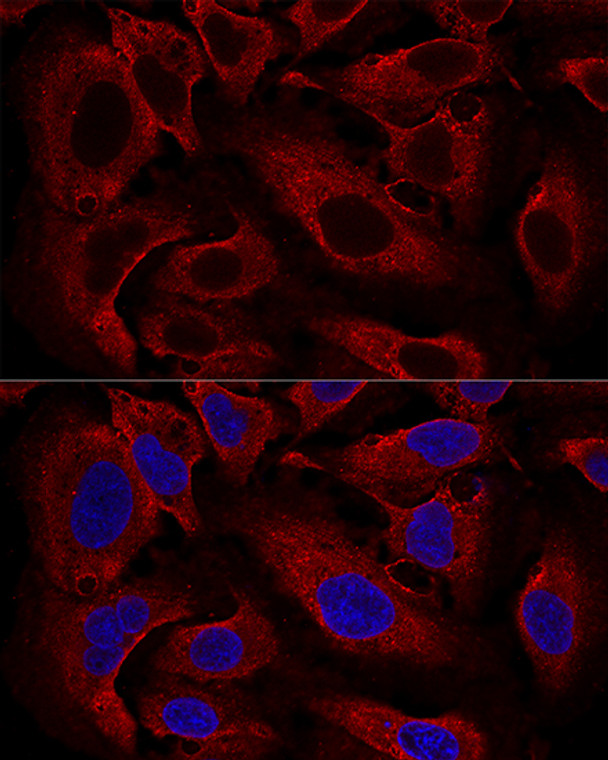| Host: |
Rabbit |
| Applications: |
WB/IF |
| Reactivity: |
Human/Mouse |
| Note: |
STRICTLY FOR FURTHER SCIENTIFIC RESEARCH USE ONLY (RUO). MUST NOT TO BE USED IN DIAGNOSTIC OR THERAPEUTIC APPLICATIONS. |
| Short Description: |
Rabbit polyclonal antibody anti-ARL8B (127-186) is suitable for use in Western Blot and Immunofluorescence research applications. |
| Clonality: |
Polyclonal |
| Conjugation: |
Unconjugated |
| Isotype: |
IgG |
| Formulation: |
PBS with 0.01% Thimerosal, 50% Glycerol, pH7.3. |
| Purification: |
Affinity purification |
| Dilution Range: |
WB 1:500-1:3000IF/ICC 1:50-1:200 |
| Storage Instruction: |
Store at-20°C for up to 1 year from the date of receipt, and avoid repeat freeze-thaw cycles. |
| Gene Symbol: |
ARL8B |
| Gene ID: |
55207 |
| Uniprot ID: |
ARL8B_HUMAN |
| Immunogen Region: |
127-186 |
| Immunogen: |
Recombinant fusion protein containing a sequence corresponding to amino acids 127-186 of human ARL8B (NP_060654.1). |
| Immunogen Sequence: |
VLGNKRDLPNALDEKQLIEK MNLSAIQDREICCYSISCKE KDNIDITLQWLIQHSKSRRS |
| Post Translational Modifications | Ubiquitinated at Lys-141 by RNF167, leading to its degradation. |
| Function | Small GTPase which cycles between active GTP-bound and inactive GDP-bound states. In its active state, binds to a variety of effector proteins playing a key role in the regulation of lysosomal positioning which is important for nutrient sensing, natural killer cell-mediated cytotoxicity and antigen presentation. Along with its effectors, orchestrates lysosomal transport and fusion. Localizes specifically to lysosomal membranes and mediates anterograde lysosomal motility by recruiting PLEKHM2, which in turn recruits the motor protein kinesin-1 on lysosomes. Required for lysosomal and cytolytic granule exocytosis. Critical factor involved in NK cell-mediated cytotoxicity. Drives the polarization of cytolytic granules and microtubule-organizing centers (MTOCs) toward the immune synapse between effector NK lymphocytes and target cells. In neurons, mediates the anterograde axonal long-range transport of presynaptic lysosome-related vesicles required for presynaptic biogenesis and synaptic function. Also acts as a regulator of endosome to lysosome trafficking pathways of special significance for host defense. Regulates cargo trafficking to lysosomes by binding to PLEKHM1 and recruiting the HOPS subunit VPS41, resulting in functional assembly of the HOPS complex on lysosomal membranes. Plays an important role in cargo delivery to lysosomes for antigen presentation and microbial killing. Directs the intersection of CD1d with lipid antigens in lysosomes, and plays a role in intersecting phagosomes with lysosomes to generate phagolysosomes that kill microbes. Involved in the process of MHC II presentation. Regulates the delivery of antigens to lysosomes and the formation of MHC II-peptide complexes through the recruitment of the HOPS complex to lysosomes allowing the fusion of late endosomes to lysosomes. May play a role in chromosome segregation. (Microbial infection) During Mycobacterium tuberculosis (Mtb) infection, is required for plasma membrane repair by controlling the exocytosis of lysosomes in macrophages. ARL8B secretion pathway is crucial to control the type of cell death of the M. tuberculosis-infected macrophages, distinguishing avirulent from virulent Mtb induced necrotic cell death. (Microbial infection) During infection, coronaviruses such as SARS-CoV-2 and the chaperone HSPA5/GRP78 are probably co-released through ARL8B-dependent lysosomal exocytic pathway for unconventional egress. |
| Protein Name | Adp-Ribosylation Factor-Like Protein 8bAdp-Ribosylation Factor-Like Protein 10cNovel Small G Protein Indispensable For Equal Chromosome Segregation 1 |
| Cellular Localisation | Late Endosome MembraneLysosome MembraneCytoplasmCytoskeletonSpindleCell ProjectionAxonSynapseCytolytic Granule MembraneGtp-Bound Form Resides On Lysosomal MembranesWhereas Gdp-Bound Form Is Likely Associated With Microtubular StructuresLocalizes With Microtubules At The Spindle Mid-Zone During MitosisIn Dendritic CellsLocalizes To Mhc Ii+ Compartments |
| Alternative Antibody Names | Anti-Adp-Ribosylation Factor-Like Protein 8b antibodyAnti-Adp-Ribosylation Factor-Like Protein 10c antibodyAnti-Novel Small G Protein Indispensable For Equal Chromosome Segregation 1 antibodyAnti-ARL8B antibodyAnti-ARL10C antibodyAnti-GIE1 antibody |
Information sourced from Uniprot.org
12 months for antibodies. 6 months for ELISA Kits. Please see website T&Cs for further guidance










